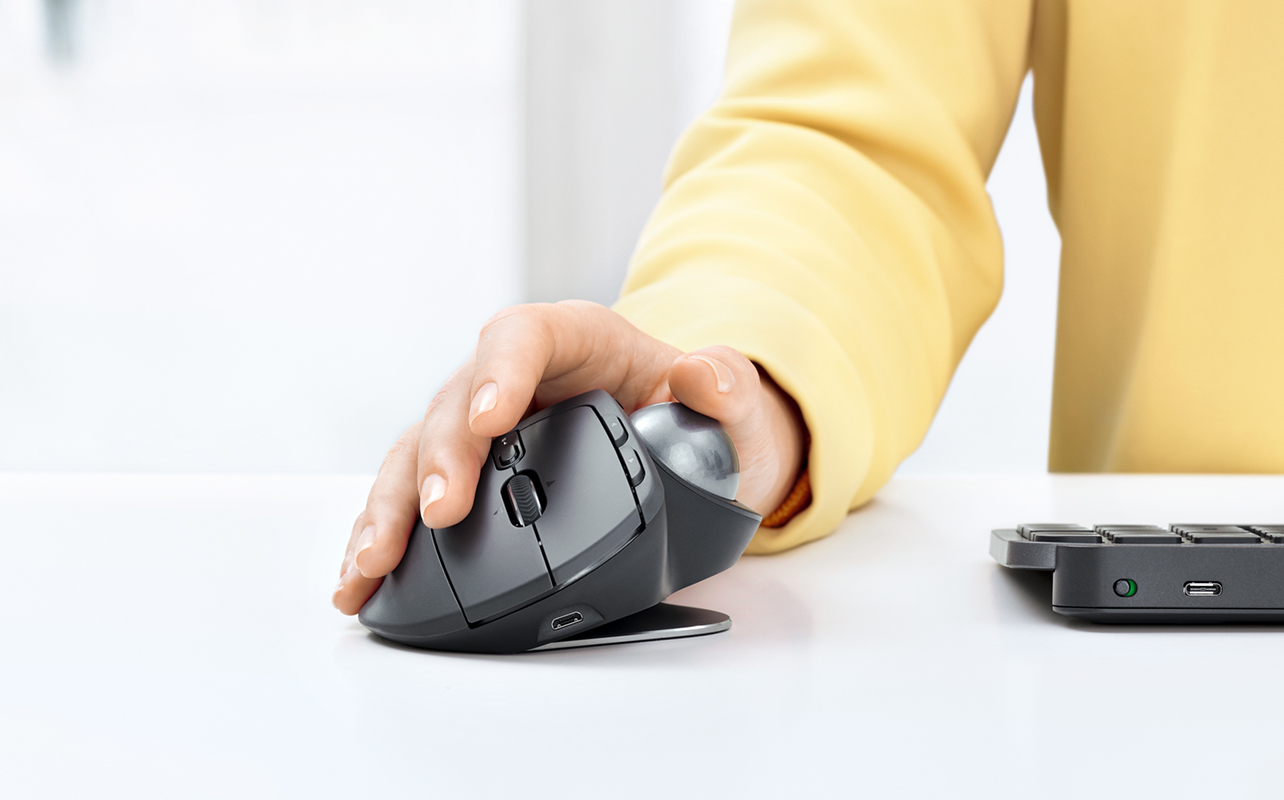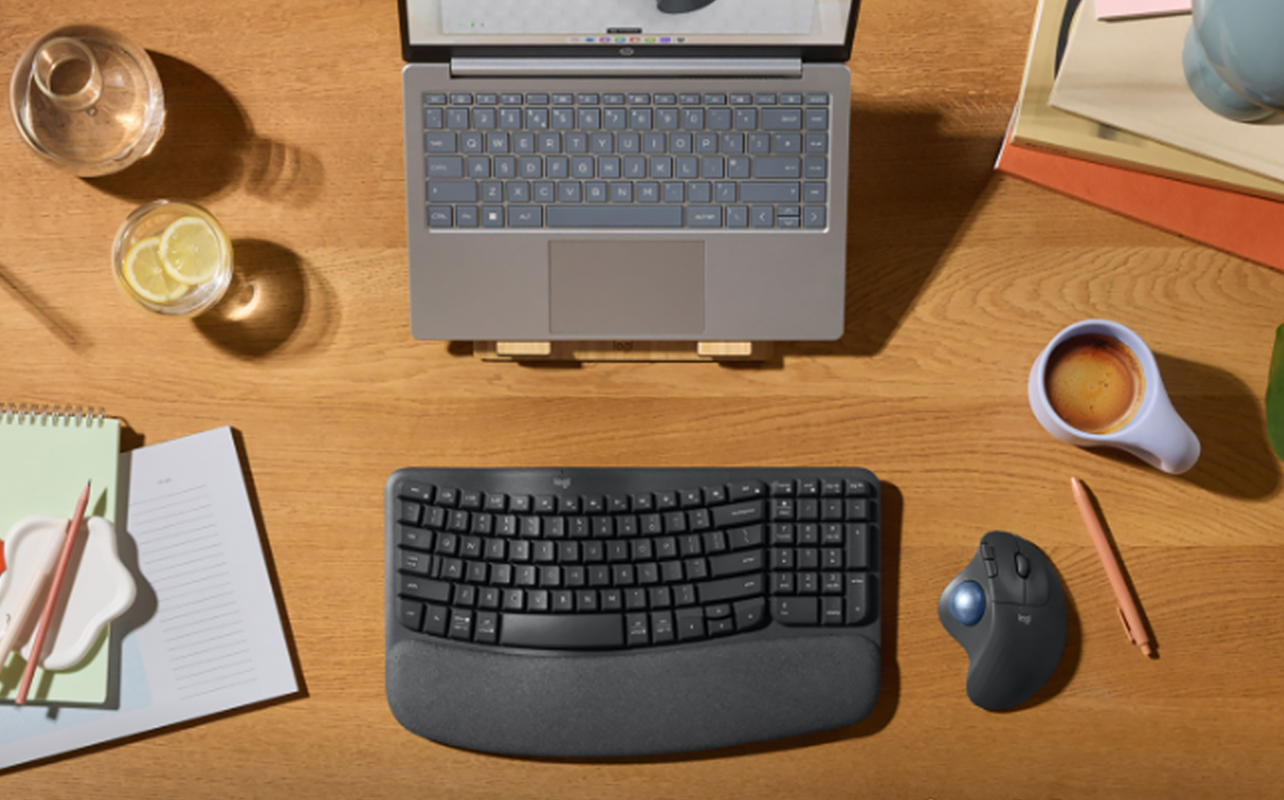
Using a mouse has been part of personal computing for decades but the concept of navigating your way around software now includes other methods, like the trackball. Comfort, speed, and efficiency are always integral factors in what works best, just like what best suits the applications you’re working with. Whether you’re a designer tackling pixel-perfect edits, a developer writing long lines of code, or a student managing tight deadlines, both a trackball mouse and traditional mouse are worth exploring.
Have you ever felt wrist fatigue using your mouse? Or, found yourself constantly adjusting your mouse position? This article is for you. We’ll break down how trackball and traditional mouse devices work, their ergonomic perks, how they affect your workflow, and which one might be the better fit based on your setup—especially if desk space is tight or you work from home.
How trackball and traditional mice work
Let’s start with the basics.
A trackball mouse stays put. Instead of moving the entire device, you rotate a ball—usually with your thumb or fingers—to move the cursor. The internal sensors detect the rotation and translate it into pointer movement on your screen.
A traditional mouse, on the other hand, uses an optical (or sometimes laser) sensor to track movement across a flat surface. You physically move the mouse to move the pointer on your screen. It’s the most common type of mouse, and you’ll find it in most offices, homes, and laptop bags.
Quick pros and cons snapshot
| Mouse type | Pros | Cons |
|---|---|---|
| Trackball Mouse | Saves desk space, reduces wrist strain, great for precision tasks | Steeper learning curve, not ideal for fast-paced gaming, requires cleaning |
| Traditional Mouse | Familiar and easy to use, great for quick cursor movements, widely available | Requires more hand/wrist movement, needs desk space, wears out quicker |

Ergonomics and comfort
Comfort is key—especially if you’re putting in long hours at your desk. When comparing an ergonomic trackball and traditional mouse, one of the biggest differences is wrist posture. With a traditional mouse, your wrist moves side to side to guide the cursor. Over time, that repetitive motion can cause strain, especially without proper wrist support.
A trackball keeps your wrist in a more neutral position. Since the device stays stationary, all movement happens with your fingers or thumb. This can dramatically reduce wrist and arm fatigue—making it a favourite among people dealing with carpal tunnel syndrome or repetitive strain injuries. Because trackballs don’t need to move around, they fit comfortably in small work areas. If you’re working on a narrow table, a mobile desk, or in a shared workspace, a trackball frees up valuable real estate and keeps everything within reach.
Productivity and workflow efficiency
Your mouse does a lot of the heavy lifting when you’re crunching spreadsheets, designing layouts, or browsing research material.
A trackball mouse excels in tasks that need precision control. Think of photo editing, CAD modelling, or editing timelines in video software. Since you don’t have to constantly reposition the mouse, your cursor can move fluidly and accurately with just a flick of the thumb or finger. This gives trackballs an edge when it comes to coding and design because small, accurate movements can be more precise. Trackballs are also great for scrolling—some models have scroll rings or built-in tilt functions, making it easier to navigate long documents or web pages.
Traditional mouse, however, still holds an advantage in fast-paced pointer control. If you’re jumping between tabs, apps, or monitors, the speed and responsiveness of a regular mouse can’t be beat. It’s often the go-to choice for general productivity and web browsing.
Desk space and mobility
If you’re working from a tiny home office nook—or the corner of your kitchen table—every inch counts. Trackballs shine in small spaces. Because they don’t move around, you don’t need a large mouse pad or open desk area. That’s one of the standout desk space trackball benefits, especially for remote workers or students on the go. Even if you wanted to use one with a laptop on a couch, it would be far easier to manage than attempting the same with a mouse.
Despite that, traditional mice are still more mobile-friendly. They’re lighter, often wireless, and pair easily with laptops. You can toss one in your bag and use it anywhere, on virtually any surface, which makes it practical for people who often switch work locations.
Learning curve and adaptability
Have you ever tried trackballs before? They can feel weird at first and it might take a few days to break old habits if you’ve never used one. Like many users, once you get used to the finger or thumb-controlled motion, you might never go back to traditional mouse.
Traditional mice are intuitive and familiar. Most of us have used one since we first touched a computer, which makes them second nature to operate. From drag-and-drop actions to quick clicks and scrolls, they work exactly how we expect them to—no learning curve required for many. As they’ve evolved to include extra buttons and scroll wheels, the concept of a mouse hasn’t changed at all, just the ergonomics have.
Maintenance and durability
When it comes to keeping your device clean and working smoothly, there are some trade-offs. Trackballs require occasional cleaning. Since the ball is exposed, it can collect dust and debris over time. Luckily, most models make it easy to pop the ball out for a quick wipe. Traditional mice, especially those with Teflon feet, wear down with constant movement. If your mousepad is dirty or you use a hard surface, it can lead to inconsistent tracking or scratches on your desk.
In general, trackballs tend to last longer, simply because there are fewer moving parts in contact with your desk.

Choosing the right option
Still not sure which one’s right for you? Here’s a quick guide based on your work style:
Office workers and designers: If you’re doing long sessions of editing documents, graphic design, or admin tasks, an ergonomic trackball may be a game-changer. It reduces wrist fatigue and provides better precision, especially when working on detailed layouts or spreadsheet cells.
Students and casual users: A traditional mouse remains a top pick for students and everyday users. It’s affordable, portable, and immediately easy to use across any laptop or desktop setup.
Small or shared desks: The trackball shines here. Since the device doesn’t need to move, you can maximize every inch of your workspace without sacrificing performance.
Ergonomic trackball and mouse picks at Best Buy Canada
Here are some standout models available at Best Buy that blend comfort, performance, and value.
Trackballs:
- Logitech Ergo M575S: A thumb-controlled wireless trackball with an ergonomic shape, it’s great for all-day comfort and easy to clean. Ideal for office workers and remote setups.
- Kensington Expert mouse: Designers love this large finger-controlled trackball for its precision and scroll ring. It suits creative professionals.
- Kensington Orbit 1600 DPI: Offering DPI switching and button customizations, it fits larger hands and great for programmers or multitaskers.
Traditional mice:
- Logitech MX Master 3S: Ergonomic design, fast scrolling, and customizable buttons, it’s perfect for power users juggling multiple applications.
- Microsoft Surface Precision: Sleek, comfortable, and ideal for productivity tasks, it offers smooth tracking and solid battery life.
- Kensington Pro Fit Ergo: Designed for ergonomics but still sleek, it suits remote professionals who need a comfortable mouse with style.
Switching to trackball mouse?

Here’s a few tips before you commit:
- Try before you buy: Visit your local Best Buy store to try a demo trackball mouse and see how it feels in your hand.
- Adjust your settings: Change the pointer speed and sensitivity in your computer’s settings. Slower speeds often make the learning curve more manageable.
- Give it time: It might feel awkward at first, but stick with it for a few days. Your muscle memory will catch up, and the benefits will become more noticeable.
- Use both if needed: Consider a hybrid setup—use a trackball for editing or coding, and a standard mouse for casual browsing or presentations.
These trackball productivity tips will help smooth the transition and let you get the most from your device—whichever route you choose.
Maximize your workflow comfort
When it comes to trackball and traditional mouse, there’s no universal winner. It’s about choosing the right tool for your workspace and the kind of work you do. If your setup is tight and your tasks precision-heavy, a trackball could seriously improve your comfort and speed. If you value portability and responsiveness, a traditional mouse still holds its ground. From ergonomic trackball vs mouse considerations to trackball productivity tips, the key is finding what helps you work better and feel better.
Ready to rethink your workflow? Explore Best Buy’s selection of traditional and trackball mice. Your next productivity upgrade might just be sitting under your hand.





